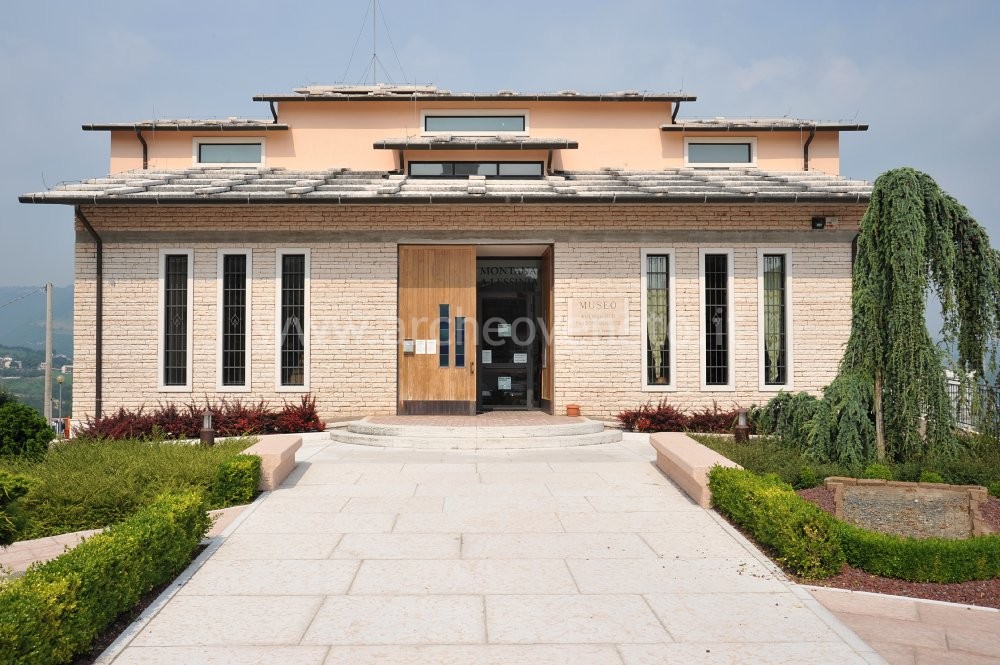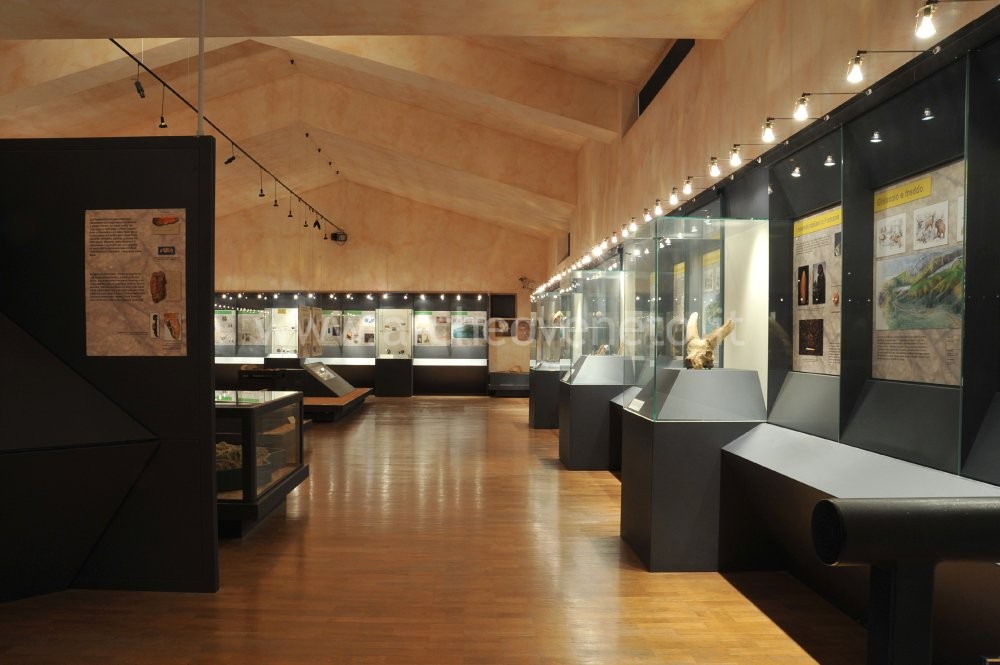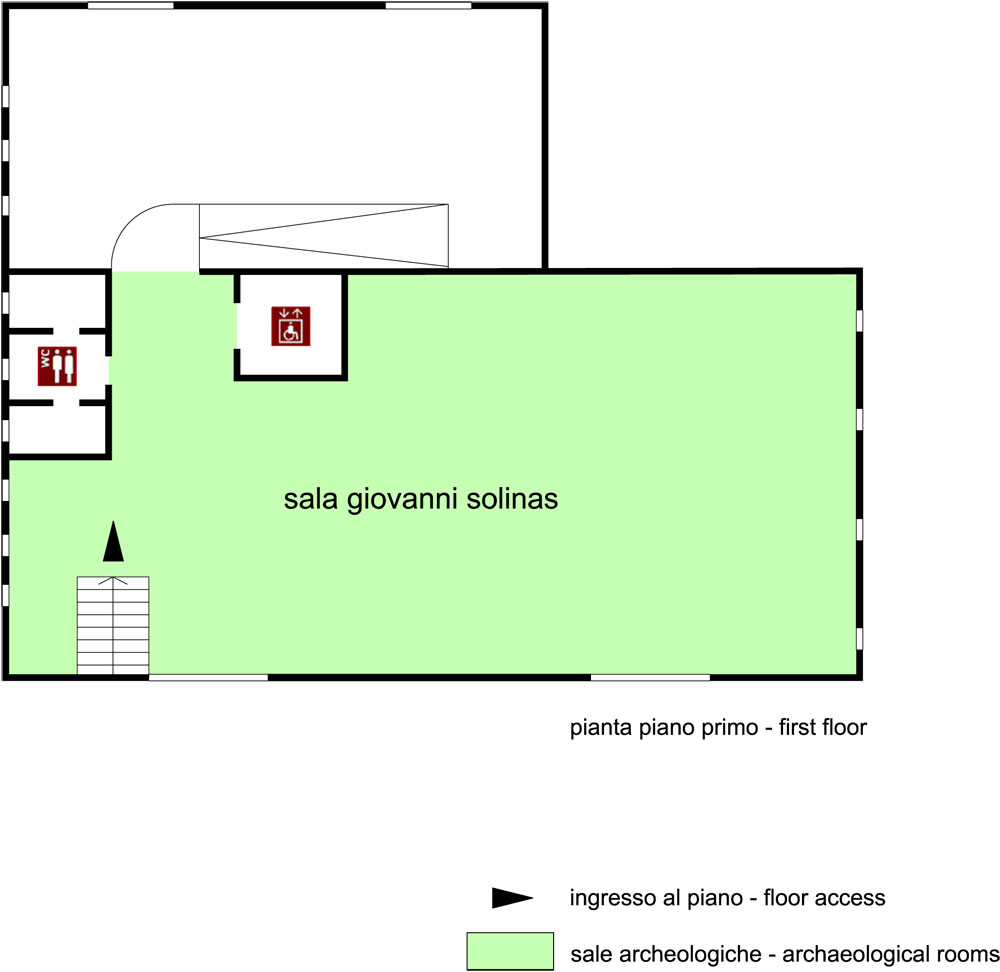|
|
File
Prehistoric and Paleontological Museum – Sant’Anna d’Alfaedo
|
Piazza Dalla Bona – 37020 Sant’Anna d’Alfaedo (VR)
– Fax 045 7532121 |
  |
|
Summary

The first floor of the Museum of Sant’Anna d’Alfaedo, which is located in a modern stone building, hosts an important collection of archaeological finds discovered in the western area of Lessinia. The prehistoric section complements the paleontological exhibition on the ground floor, which is mainly devoted to the Prun stone (stone from Lessinia) and to the large marine vertebrate fossils. The museum is part of the Regional Natural Park of Lessinia, managed by the local Mountain Community and it is networked to other museums and protected areas that are members of the Park itself.
Collection history
The first research carried out in the area of Sant’Anna d’Alfaedo was accomplished in the mid nineteenth century by Stefano de Stefani, who with a great passion discovered numerous prehistoric traces in the area of western Lessinia. Between 1915 and 1930 Raffaello Battaglia dealt mainly with the study of prehistory in Lessinia; he found many pre-historic traces and checked the work that had previously been carried out by other scholars. After the second world war, Francesco Zorzi carried on the excavation and the prehistoric survey in the area of Sant’Anna. His commitment reached its peak in the 60’s with the establishment of the Museum of Natural History, located in the Town Hall, which displayed both prehistoric and paleontological finds of the local area. Then in the late 90’s the Museum was moved to its current location.
|

 The prehistoric section of the museum starts with the presentation of the first settlement in Lessinia, which dates back to the Lower Paleolithic (300,000-120,000 years ago). A flint biface found in Cà Pauli can be traced back to this era, which is otherwise scarcely known. The following display cases are devoted to the Middle Paleolithic (120,000-36,000 years ago) and to the archaeological finds of this time found in the Lessinian Mountains and in particular in the Fumane cave. This shelter, which was discovered already in the nineteenth century, contains an extraordinary stratigraphic sequence, which provides very important information on the environmental evolution in Lessinia and on human history. A display case contains the “Levallois” flake, two scrapers and the skull of an ibex (probably a hunting trophy) found inside the cave and dating back to the Middle Paleolithic, which was characterized by the presence of the Homo Neanderthalensis. The Upper Paleolithic (36,000-10,000 years ago) saw the appearance of the Homo Sapiens Sapience. This era was characterized by the systematic use of bone and antler to manufacture ornamental objects (assegais, bone tools, a herbivore rib with notches and pierced seashells) as well as by the production of stone tools, known as Aurignacian industry (split based spear points, blades and flakes with abrupt marginal retouch, scrapers and burins with retouched blades and flake cores). The prehistoric section of the museum starts with the presentation of the first settlement in Lessinia, which dates back to the Lower Paleolithic (300,000-120,000 years ago). A flint biface found in Cà Pauli can be traced back to this era, which is otherwise scarcely known. The following display cases are devoted to the Middle Paleolithic (120,000-36,000 years ago) and to the archaeological finds of this time found in the Lessinian Mountains and in particular in the Fumane cave. This shelter, which was discovered already in the nineteenth century, contains an extraordinary stratigraphic sequence, which provides very important information on the environmental evolution in Lessinia and on human history. A display case contains the “Levallois” flake, two scrapers and the skull of an ibex (probably a hunting trophy) found inside the cave and dating back to the Middle Paleolithic, which was characterized by the presence of the Homo Neanderthalensis. The Upper Paleolithic (36,000-10,000 years ago) saw the appearance of the Homo Sapiens Sapience. This era was characterized by the systematic use of bone and antler to manufacture ornamental objects (assegais, bone tools, a herbivore rib with notches and pierced seashells) as well as by the production of stone tools, known as Aurignacian industry (split based spear points, blades and flakes with abrupt marginal retouch, scrapers and burins with retouched blades and flake cores).
Another archaeological site providing precious information on the environment and the human activities in Lessinia between the Middle Paleolithic and the Upper Paleolithic is the Riparo Tagliente cave. In this site, researchers have discovered examples of artistic expressions (cobblestones with the representation of heads of felines, ibexes or bison) numerous flint tools of the late Epigravettian period (tools with abrupt retouch, burins, scrapers and cores) and tools that are not made of stone (assegais, bone awls and scrapers, teeth of animals and seashells). Inside the cave, a burial has been discovered (that has then been reconstructed in a corner of the room) of a young man laid in the grave and covered with stones, one of which displays the representation of a lion.
In the middle of the room there is a cast of the Aurignacian fireside, found at the entrance of the cave, which has allowed, thanks to the carbon 14 method, to trace back the deposit to a time span between 36,000 and 33,000 years ago.
The improvement of the climate conditions, occurred after the end of the last Ice Age, together with the coming of the Neolithic (8th millennium B.C.), marked the beginning of farming and stock-breeding. Also the production of tools changed according to the new needs and new objects made their appearance, which were linked to the farming world, such as axes in polished stone, sickles, millstones and ceramic vessels. On the Lessian mountains, the excavation has dug up numerous traces of a settlement that can be traced back to the Fiorano Culture (mid 6th millennium B.C.); they include a fragment of a flask-shaped vase, a truncated-conical bowl with a small vertical handle, a small olla with egg-shaped body and some fragments of hull-shaped decorated jugs. In the fifth millennium approximately, a new culture developed in northern Italy. The first expressions of this culture, known as the “square mouth vases” culture, can be seen in the pottery discovered in Sant’Ambrogio di Valpolicella. The end of this culture (and the beginning of the so-called “bell-shaped” culture) is witnessed by the discovery of the archaeological finds from the sites of Scalucce di Molina and Colombare di Negrar, which include fragments of square mouth and round profile vessels, bell-shaped vases and artefacts in split stone produced with the Campignian technique. As regards the world of the dead, there have been two important discoveries: a grave with two buried bodies in foetal position surrounded by stone slabs, which was found in the Progno (dialectal word meaning narrow valley) of Fumane, and two biconical vases, which were probably part of the grave goods found in the cave of Vajo della Lora. The area of the Lessinian mountains was massively inhabited during the second half of the 2nd millennium B.C. (Bronze Age), when the fortified centre of Guaite was founded. The lithic tools found here include, a small dagger, a pin, a needle, some arrowheads and different kinds of crescent shaped handles. Another important site is the one in Monte Loffa, surveyed in the 19th century by De Stefani and in the 20th century by Zorzi, which hosted a village in the Middle Bronze Age. The display case referring to this site includes items that date back to the earliest phases of the Bronze Age, such as some fragments of decorated ollas and bowls, crescent-shaped handles, axes in polished stone, pedunculate arrowheads with concave base, a Campignian tool, a scraper and a sickle.
At the beginning of the Iron Age (1st millennium B.C.), the population on the Lessinian Mountains increased and settled in villages located on the mountain tops; at the time, the dwellings were mainly basement houses with walls made of limestone blocks (“stone villages”). The most significant centres were San S. Giorgio di Valpolicella, Castelrotto, Monte Loffa and Castel Sottosengia. The excavation in the settlement of Monte Loffa lead to the discovery of ollas, jugs, bowls, stone spindle whorls, metal tools used for daily activities (pickaxe, axes, billhook, knives), ornamental objects both of Venetian origin (fibulae, small rings, pins, bracelets and pendants) and of Celtic origin (bracelets, glass beads and fibulae). The items found in the site of Sottosengia include loom weights, a belt hook, an arrowhead, a spearhead, sharpening stones, a small egg-shaped olla and some jugs. The protohistoric settlement in Castelrotto is well known for its geographic position: overlooking the Adige river, it was at the crossroads of contacts between Venetian people living in the plain, the Etruscan villages in the area of Mantua and the communities living on the hills and the Lessinian mountains. The display case referring to this site contains some ceramic items, such as bowls of different sizes, a small olla, a grater and some jugs.
The Romanization period in this area (2nd – 1st cent. B.C.) is mainly reported by the discovery of some coins dating back to the Republican age, which bear witness to the hypothesis that the first contacts with Rome were linked to trade.
The finds discovered in Lessinia also include the first examples of writing in Rhaetic alphabet: there are two inscribed loom weights (from Monte Loffa), a spindle whorl with an inscription (from Monte Loffa) and the bottom of a bowl with alphabetical signs (from Castelrotto).
The last panel, which is placed in the middle of the room, is devoted to don Alberto Benedetti, who studied the local history of Sant’Anna d’Alfaedo.
|

Admission: Su prenotazione
Negli orari di apertura
Ticket: Si
Price: Full fare: 3€; Reduced fare: 2€ (children aged between 6 and 12, groups); Free admission (children below 6 years of age, disabled and their helpers)
 School access School access
 Disabled access Disabled access
Opening Days
| Tipology |
When |
Specs |
| 1/06 – 30/09 |
Wednesday |
10.00 – 12.00 e 16.00 – 18.00 |
| 1/06 – 30/09 |
Friday |
10.00 – 12.00 e 16.00 – 18.00 |
| 1/06 – 30/09 |
Saturday |
10.00 – 12.00 e 16.00 – 18.00 |
| 1/06 – 30/09 |
Sunday |
10.00 – 12.00 e 16.00 – 18.00 |
Out of the opening time the Museum can be visit only upon reservation.
Recommended tour time (minutes): 30
 Toilet Toilet
 Parking Parking
 Bookshop Bookshop
 Rest points Rest points
 Guide a stampa Guide a stampa
Brochure
Italian
 Information boards Information boards
Italian
 Mobile cards Mobile cards
English and German
 Captions under exhibits Captions under exhibits
Italian
 Multilingual ads: Inglese Multilingual ads: Inglese
Tedesco
Information sheets
 Guided Tours Guided Tours
 Educational activities Educational activities
 Educational workshops Educational workshops
 Library and documentation centre Library and documentation centre
 Other activities Other activities
Didactic workshop
| Musei e raccolte archeologiche del Veneto 2004, a cura di Di Mauro A., Dosson di Casier, pp. 129. |
| Bonetto J. 2009, Veneto (Archeologia delle Regioni d’Italia), Roma, pp. 366. |
|

